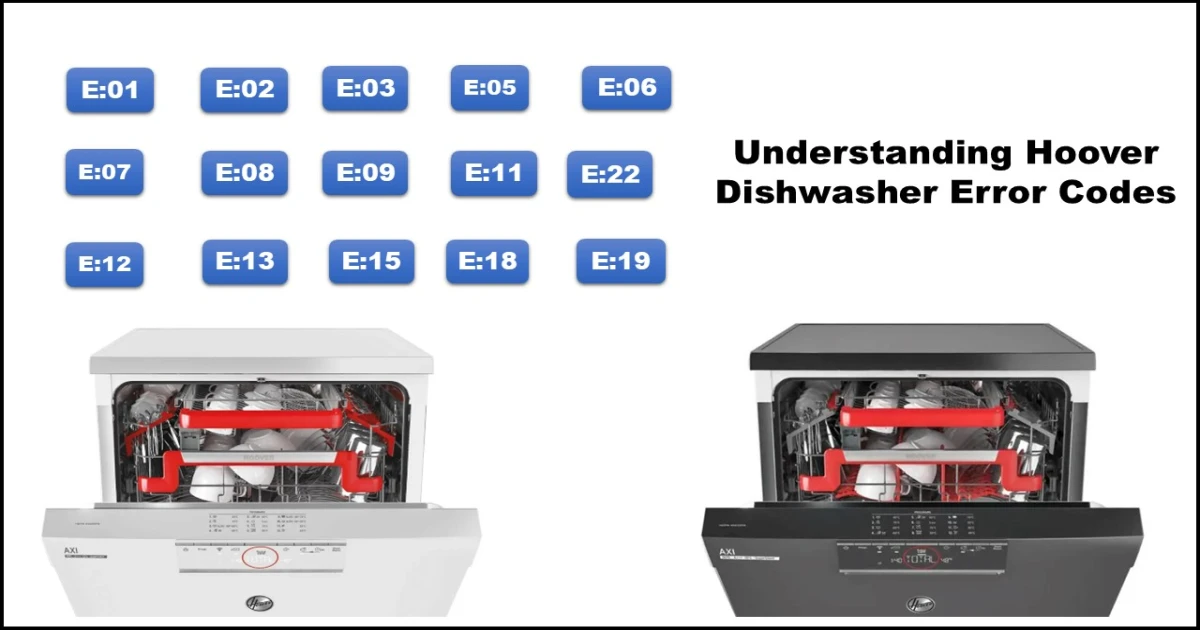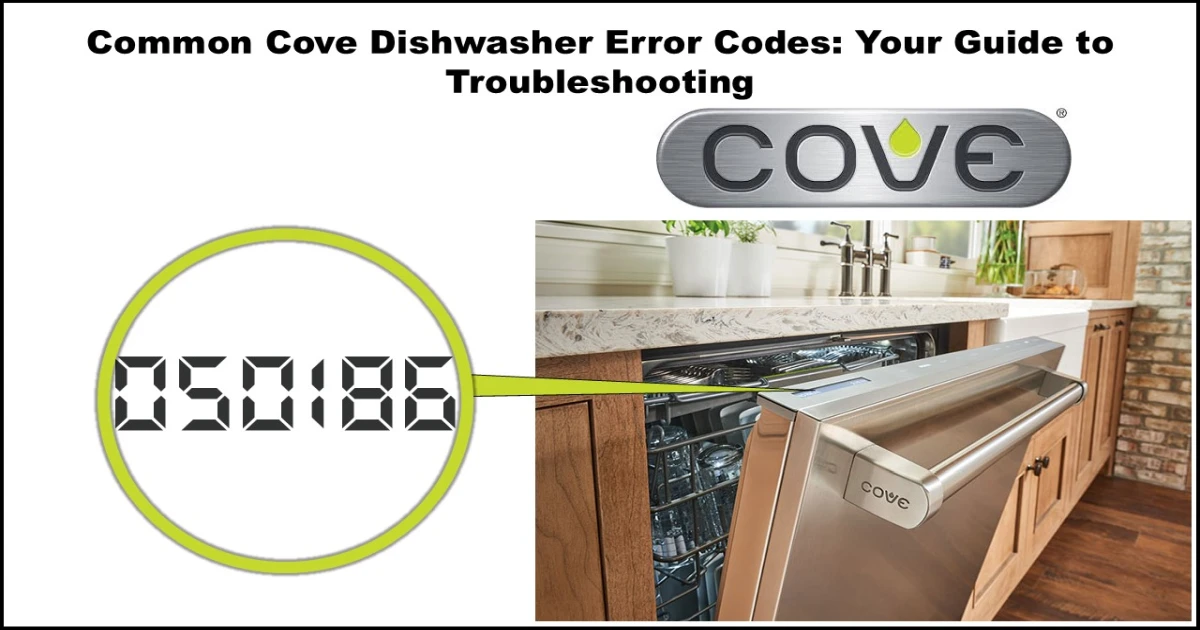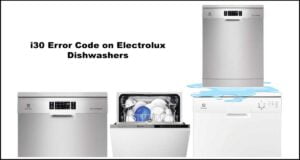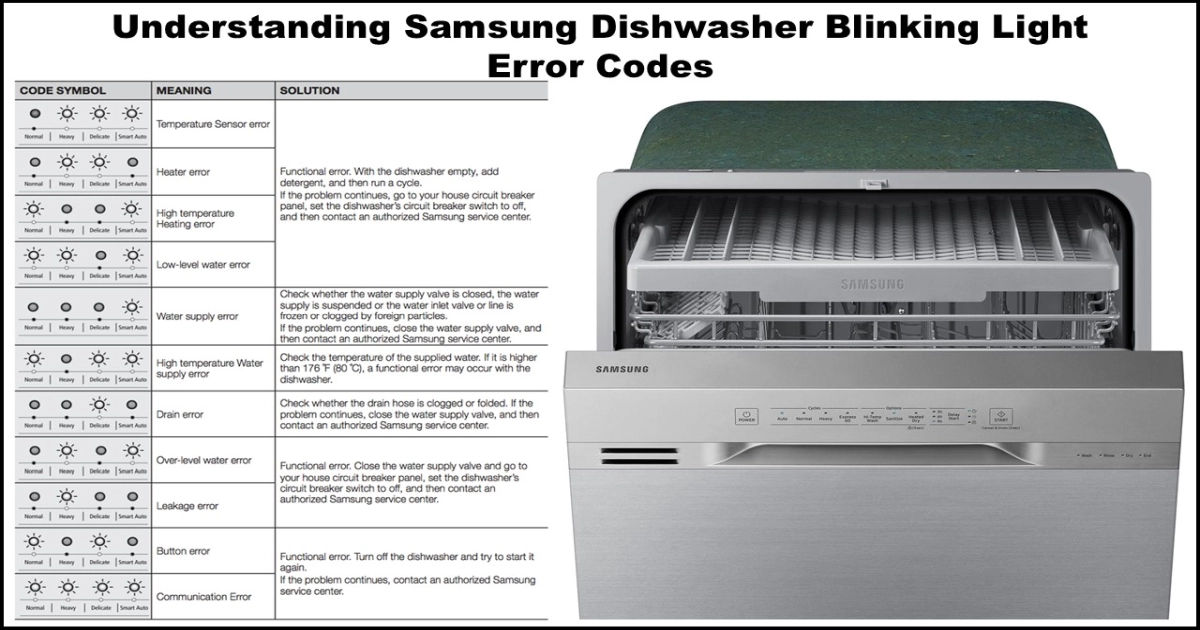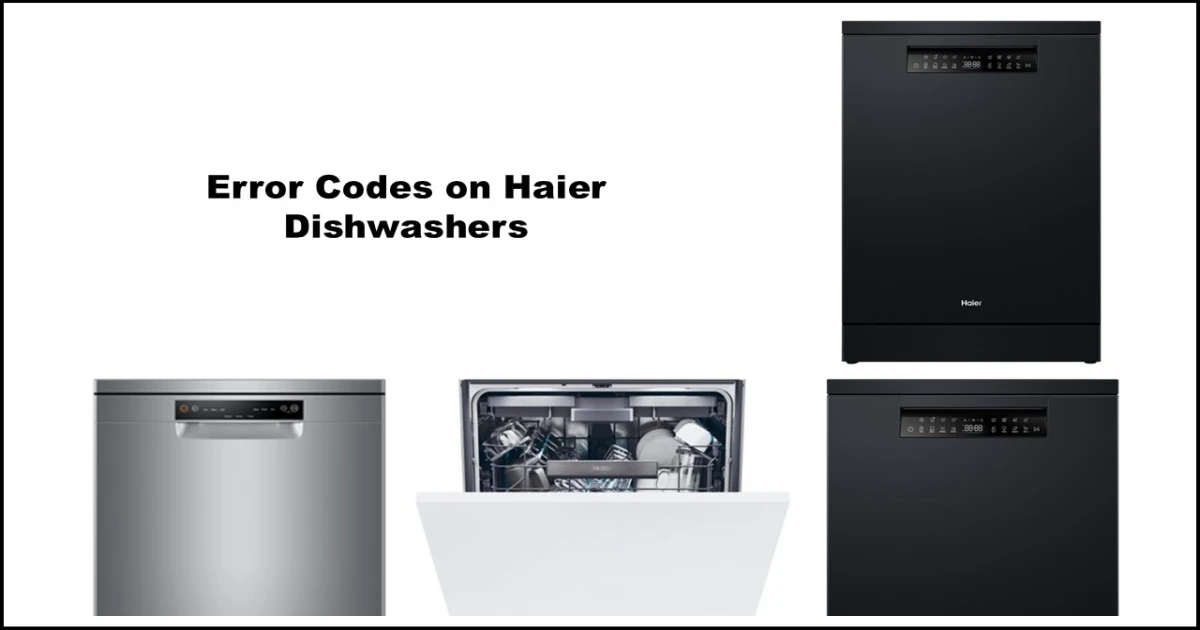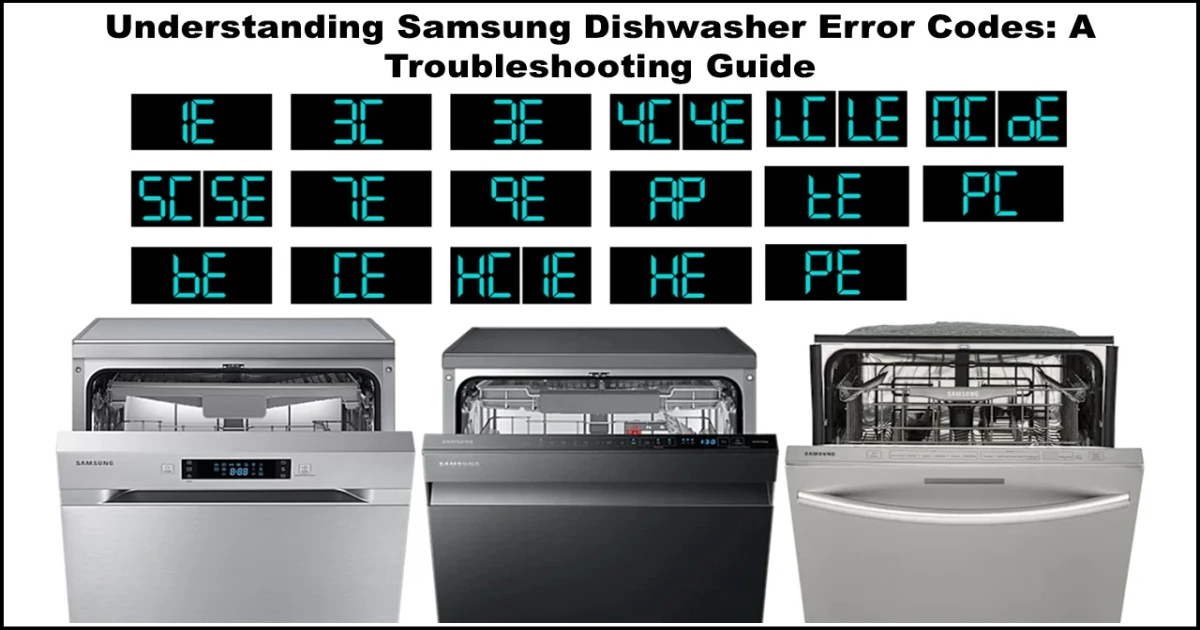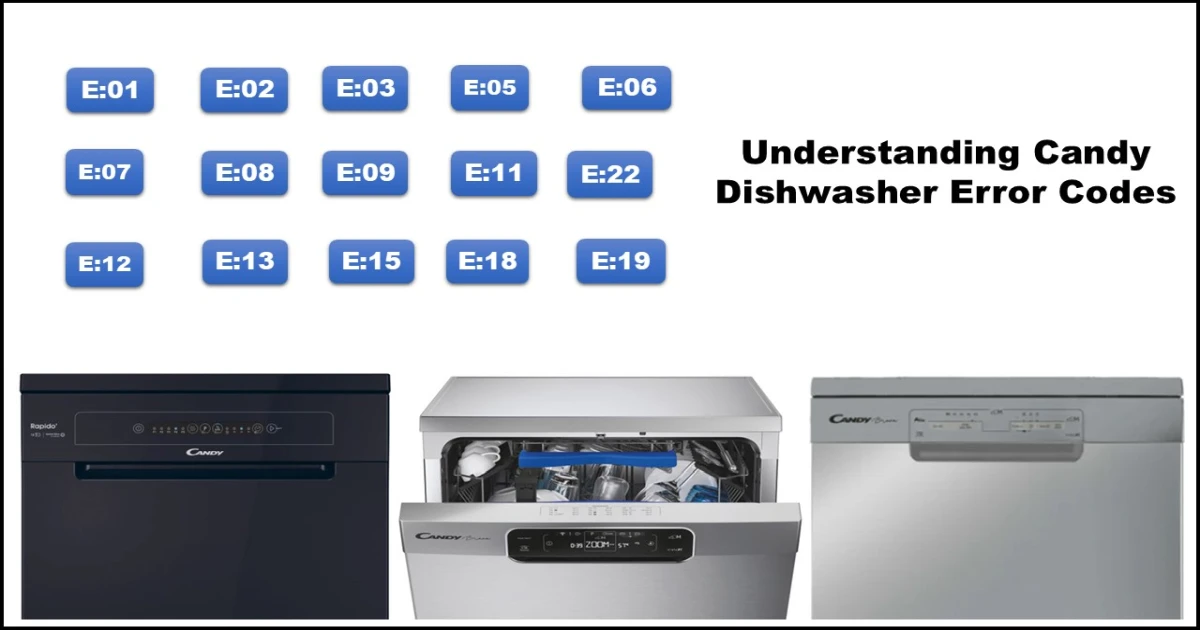Troubleshooting Your Hisense Dishwasher: A Guide to Understanding Error Codes
This guide explains some of the most common Hisense dishwasher error codes you might encounter and provides potential solutions.
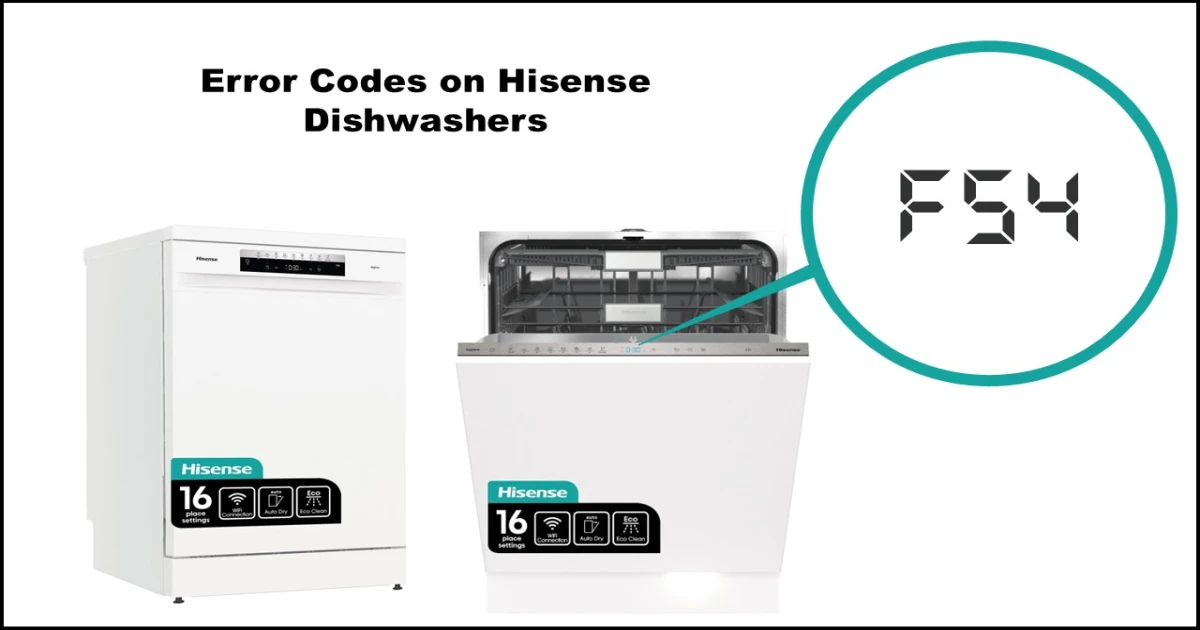
Before You Begin: Safety First!
Always prioritize your safety when troubleshooting any appliance. Before inspecting or attempting any repairs, ensure the dishwasher is turned off and unplugged from the power source. This prevents the risk of electrical shock.
Hisense Dishwasher Error Codes Explained:
Here are common error codes and their potential causes and solutions:
F10: Water Inlet Error (Excessive Water)
This code typically indicates that the dishwasher has detected an abnormally high water level. This could be due to a continuous fill issue or a problem with the water level sensing.
- Possible Causes:
- Malfunctioning water inlet valve that is not closing properly.
- Faulty float switch that is stuck or not signaling correctly.
- Clogged drain system preventing water from exiting, leading to accumulation.
- Issue with the pressure sensor.
- Problem with the flowmeter incorrectly measuring water intake.
- Solutions:
- Turn off and unplug the dishwasher for safety.
- Inspect the float switch: Located in the base of the dishwasher tub, ensure it is not obstructed by debris and can move freely. Clean the area around it if necessary.
- Check the drain system: Examine the drain hose for kinks or blockages. Clean the drain pump filter and the sump area at the bottom of the dishwasher, removing any food particles or debris.
- Inspect the water inlet valve: Located where the water supply hose connects to the dishwasher, check for any visible issues or debris preventing it from closing fully.
- Verify the drain hose connection: Ensure the drain hose is correctly installed and not pushed too far into the drain pipe, which can cause siphoning.
- If the issue persists, the water inlet valve, flowmeter, pressure sensor, or the main control board may require professional diagnosis and replacement.
F11: Water Outlet Error
This code signals that the dishwasher is having trouble draining water. This means the drain pump is not effectively removing water from the tub.
- Possible Causes:
- Clogged or kinked drain hose.
- Blocked drain pump or drain filter.
- Issue with the hydraulic sump.
- Faulty drain pump.
- Wiring issue to the drain pump.
- Solutions:
- Turn off and unplug the dishwasher for safety.
- Check the drain hose: Ensure it is not kinked, bent, or blocked. Disconnect it if necessary to check for obstructions.
- Clean the drain filter and pump: Access the drain filter at the bottom of the dishwasher and clean it thoroughly. Inspect the drain pump impeller for any foreign objects.
- Check the hydraulic sump: Ensure this area is also free of blockages.
- Verify the yellow locking plug: As mentioned in the original text, ensure this is properly connected if applicable to your model.
- Inspect the drain pump wiring: Check for any loose or damaged connections.
- Test the drain pump (advanced): If comfortable and with the power off, you can manually check if the drain pump impeller spins freely. Using a multimeter to check for the correct resistance (Ohm value) can indicate if the pump is faulty, but be aware that Ohm values can vary by model.
- If these steps do not resolve the issue, the drain pump or the main control board likely needs to be replaced by a technician.
F12: Water Inlet Fault (Insufficient Water)
This code indicates a problem with the dishwasher filling with enough water within a set time.
- Possible Causes:
- Water supply turned off or insufficient water pressure.
- Kinked or blocked water inlet hose.
- Clogged filter screen on the water inlet valve.
- Faulty water inlet valve.
- Problem with the flowmeter not accurately measuring water intake.
- Issue with the main control board.
- Solutions:
- Turn off and unplug the dishwasher for safety.
- Check the water supply: Ensure the hot water tap connected to the dishwasher is fully open and that there is adequate water pressure.
- Inspect the water inlet hose: Look for any kinks, twists, or blockages.
- Clean the inlet filter: There is usually a small filter screen where the water inlet hose connects to the dishwasher valve. Turn off the water supply, disconnect the hose, and clean this filter.
- Inspect the water inlet valve: While power is off, visually inspect the valve for any obvious damage. Ohm testing can indicate a faulty valve, but values can vary by model (a typical range was mentioned as 0.9 KΩ @ 120V ac | 4 KΩ @ 220 Vac, but verify for your specific model).
- Check the flowmeter: Ensure its connections are secure.
- If the error persists, the water inlet valve, flowmeter, or main control board may need professional attention.
F40: Leakage on the Inlet Valve Error
This code suggests that the dishwasher’s internal leak detection system, often involving the flowmeter, has identified a leak near the water inlet valve.
- Possible Causes:
- Leaking water inlet valve or its connections.
- Leak in the dishwasher tub or door seal allowing water into the base where the leak sensor is located.
- Faulty flowmeter incorrectly detecting a leak.
- Issue with the pressure sensor.
- Problem with the main control board.
- Solutions:
- Turn off and unplug the dishwasher for safety.
- Inspect the water inlet valve and connections: Carefully examine the valve and where the water hose attaches for any signs of dripping or water residue. Tighten connections if loose.
- Check the dishwasher base: Look for any standing water in the base of the appliance (you might need to remove a kick panel). This indicates a leak.
- Examine the door gasket and seals: Ensure the door seal is clean, intact, and properly seated all around the door.
- Check the flowmeter and pressure sensor: Ensure their connections are secure. While the original text mentions checking for 5Vdc at the flowmeter, this kind of electrical testing should only be performed by a qualified technician.
- Identifying the source of the leak is crucial. If you find a leak from the valve or hoses, they may need replacement. If the leak is from the door seal, it might need cleaning or replacement.
- If no visible leak is found or the error persists, there might be an issue with the leak detection system components (flowmeter, pressure sensor) or the main board, requiring professional diagnosis.
F41: Heating Error
This code indicates a problem with the dishwasher’s ability to heat the water to the required temperature during a cycle.
- Possible Causes:
- Faulty heating element.
- Issue with the temperature sensor (NTC sensor).
- Problem with the pressure sensor.
- Faulty circulation pump not moving water over the heater.
- Wiring issues to the heating circuit.
- Faulty main control board.
- Solutions:
- Turn off and unplug the dishwasher for safety.
- Inspect the heating element: Visually check the heating element at the bottom of the tub for any signs of damage, corrosion, or burn marks.
- Check wiring and connections: Examine the wiring harness and connections leading to the heating element, temperature sensor, pressure sensor, and circulation pump for any signs of damage or looseness.
- Test the heating element (advanced): Using a multimeter to check for resistance across the heating element terminals can help determine if it’s faulty. The original text suggests a resistance around 12 ohms (at 120V ac) or 30 ohms (at 220 Vac), but confirm the correct value for your specific model using a service manual if possible. No reading (OL or infinity) typically indicates a broken element.
- Check the temperature and pressure sensors: Ensure their connections are secure. While testing resistance is possible, it requires technical knowledge and specific values for your model.
- Verify circulation pump operation: Listen for the circulation pump running during the wash cycle (when it would normally be heating).
- If the heating element appears fine and connections are secure, the issue could lie with the temperature sensor, pressure sensor, circulation pump, or the main control board, requiring professional diagnosis.
F42: Temperature Sensor Error
This code indicates that the dishwasher’s temperature sensor (NTC sensor) is detecting a temperature outside the expected range, suggesting a possible sensor malfunction or a problem with the heating system affecting temperature readings.
- Possible Causes:
- Faulty temperature sensor (NTC).
- Loose or damaged wiring to the temperature sensor.
- Problem with the heating element or circulation pump preventing proper water heating.
- Faulty main control board.
- Solutions:
- Turn off and unplug the dishwasher for safety.
- Inspect wiring and connections: Check the wiring harness and connections to the temperature sensor for any visible damage or looseness.
- Check the temperature sensor (advanced): The temperature sensor’s resistance changes with temperature. While the original text gives a value (10 KΩ at 25 °C / 77°F), verifying the correct resistance curve or value for your specific model’s NTC sensor is important for accurate testing with a multimeter.
- Verify heating element and circulation pump function: Ensure the heating element is operational (as per F41) and the circulation pump is circulating water, as issues with these can affect temperature readings.
- If the wiring is secure and other components seem functional, the temperature sensor itself is likely faulty and needs replacement. If replacing the sensor doesn’t fix it, the main board might be the issue, requiring professional service.
F43: Pressure Sensor Error
This code points to an issue with the dishwasher’s pressure sensor, which is often involved in monitoring water levels and potentially the circulation pump’s operation.
- Possible Causes:
- Faulty pressure sensor.
- Loose or damaged wiring to the pressure sensor.
- Blockages or issues in the hydraulic system affecting pressure readings.
- Faulty main control board.
- Solutions:
- Turn off and unplug the dishwasher for safety.
- Inspect wiring and connections: Check the wiring harness and connections to the pressure sensor for any visible damage or looseness.
- Check for blockages: Ensure there are no blockages in the sump or hoses that could affect pressure readings.
- Check the pressure sensor (advanced): Testing the pressure sensor’s functionality typically requires a multimeter and specific knowledge of its expected readings under different conditions, which is best left to a technician.
- If wiring is secure and no blockages are apparent, the pressure sensor or the main control board is likely the cause and requires professional diagnosis and repair.
F44: Turbidity Sensor Error
This code indicates a problem with the turbidity sensor, which measures how dirty the water is during a cycle, helping the dishwasher optimize wash settings, particularly in auto programs.
- Possible Causes:
- Dirty or obstructed turbidity sensor.
- Faulty turbidity sensor.
- Loose or damaged wiring to the turbidity sensor.
- Faulty main control board.
- Solutions:
- Turn off and unplug the dishwasher for safety.
- Clean the turbidity sensor: The sensor is usually located in the sump area at the bottom of the dishwasher. Gently clean the sensor lens to remove any food particles, grease, or residue that might be obstructing it.
- Inspect wiring and connections: Check the wiring harness and connections to the turbidity sensor for any visible damage or looseness.
- Check sensor alignment: Ensure the sensor is properly seated and aligned in its holder.
- If cleaning and checking connections don’t resolve the issue, the turbidity sensor itself may be faulty and need replacement. If the error persists after replacing the sensor, the main control board could be the problem, requiring professional assistance.
F45: Diverter Valve Error
This code signifies an issue with the diverter valve, which controls the flow of water to the different spray arms (lower, middle, upper) during the wash cycle.
- Possible Causes:
- Obstruction or foreign object blocking the diverter valve.
- Faulty diverter valve motor or mechanism.
- Loose or damaged wiring to the diverter valve.
- Faulty main control board.
- Solutions:
- Turn off and unplug the dishwasher for safety.
- Inspect the diverter valve area: While accessing the diverter valve can be complex and may require dismantling parts of the dishwasher, visually check for any obvious foreign objects around it if accessible.
- Check wiring and connections: Examine the wiring harness and connections to the diverter valve motor for any visible damage or looseness.
- Test the diverter valve motor (advanced): Checking the resistance of the diverter valve motor with a multimeter can help diagnose a fault. The original text provides typical values (3 KΩ @ 120V ac | 10 KΩ @ 220 Vac), but confirm the correct value for your specific model.
- If a blockage is found and removed, the error might clear. Otherwise, a faulty diverter valve or the main control board is the likely cause, requiring professional repair.
F52: Water Level 1 Error (Insufficient Fill)
Based on additional search results for Hisense, this code appears to relate to insufficient water entering the dishwasher, similar in outcome to F12 but potentially triggered by a different monitoring point or criteria.
- Possible Causes:
- Water supply issue (tap not fully open, low pressure).
- Kinked or blocked fill hose.
- Siphoning due to incorrect drain hose installation.
- Faulty water inlet valve or flowmeter.
- Problem with the pressure sensor or water level sensor.
- Solutions:
- Turn off and unplug the dishwasher for safety.
- Check the water tap and supply pressure.
- Inspect the fill hose for kinks or blockages.
- Ensure the drain hose is correctly positioned and not causing siphoning (the end should not be too low or too far into the standpipe).
- Check the water inlet valve and flowmeter as described for F12.
- Inspect connections to the pressure sensor and any water level sensor.
- If the problem persists, professional diagnosis of the water intake and sensing system is recommended.
F53: Water Level 2 Error
Information specifically for Hisense F53 in dishwashers is less common in public resources, with some results pointing to washing machines. However, in the context of water level errors (like F52), F53 might indicate a different aspect of water level detection or a related component issue in some Hisense dishwasher models. The original text suggests similar checks to F52.
- Possible Causes:
- Issues with water level sensing.
- Problems with the water valve or flowmeter accuracy.
- Drainage issues causing incorrect level readings.
- Faulty pressure sensor or water level sensor.
- Solutions:
- Turn off and unplug the dishwasher for safety.
- Inspect wiring harness for damage or loose connections.
- Check the water valve and flowmeter as described for F12/F52.
- Clean filters to ensure proper water flow and drainage.
- Ensure the drain hose is not obstructed or damaged.
- Verify the drain pump is functioning correctly.
- Professional diagnosis may be needed to pinpoint the exact cause related to water level sensing in your specific model.
F54: Float Switch Error
This code is a strong indicator that the float switch in the base of the dishwasher has been activated, typically by the presence of water where it shouldn’t be, signaling a potential leak or overflow.
- Possible Causes:
- Water leakage into the dishwasher’s base from hoses, connections, seals, or the tub.
- Stuck or faulty float switch.
- Excessive foaming within the dishwasher (e.g., from using too much detergent or incorrect detergent).
- Drainage issue causing water backup into the base.
- Solutions:
- Turn off and unplug the dishwasher for safety.
- Inspect the dishwasher base: Look for any visible water. If water is present, you need to identify and fix the source of the leak.
- Check all hoses and connections: Examine the water inlet hose, drain hose, and internal hoses for any leaks, cracks, or loose fittings.
- Inspect the door gasket and seals: Ensure they are clean, intact, and properly sealing the door.
- Check for excessive foam: If you suspect over-sudsing, this can trigger the float switch.
- Inspect and clean the float switch: Ensure it is not stuck by debris and can move freely.
- Verify proper drainage: A drainage issue can sometimes cause water to back up into the base. Check the drain system as described for F11.
- If you find a leak, the faulty component (hose, seal, connection) will need to be repaired or replaced. If no leak is apparent and the float switch is not stuck, the switch itself or the main control board might be faulty.
F56: Circulation Pump Error
This code indicates a problem with the dishwasher’s circulation pump, which is responsible for spraying water onto the dishes during the wash and rinse cycles.
- Possible Causes:
- Faulty circulation pump motor.
- Obstruction in the circulation pump.
- Loose or damaged wiring to the circulation pump.
- Issue with the pump’s capacitor (if applicable).
- Faulty main control board.
- Solutions:
- Turn off and unplug the dishwasher for safety.
- Check wiring and connections: Examine the wiring harness and connections to the circulation pump for any visible damage or looseness.
- Check for obstructions: While accessing the circulation pump directly might be difficult for the user, check the sump area and filters for any large debris that could potentially interfere with the pump.
- Listen to the pump: During a cycle, the circulation pump should make a humming or whirring sound as it runs. The absence of this sound or unusual noises could indicate a problem.
- Test the circulation pump (advanced): Measuring the resistance of the circulation pump motor with a multimeter can help diagnose a fault. The original text provides a value (61 Ω), but confirm the correct value for your specific model.
- A faulty circulation pump typically requires replacement by a qualified technician. If the pump and wiring appear fine, the issue could be with the main control board.
CLN: Appliance Must Be Cleaned
This is not an error code indicating a malfunction, but rather a maintenance reminder from the dishwasher that it needs a cleaning cycle to remove accumulated residue, food particles, and mineral buildup.
- Possible Causes:
- Regular use leading to the buildup of detergent residue, food particles, and hard water deposits.
- Infrequent cleaning of the dishwasher.
- Solutions:
- Turn off and unplug the dishwasher for safety before cleaning internal components.
- Clean the interior: Remove any large food debris from the bottom of the dishwasher.
- Clean the filter: Remove and thoroughly clean the dishwasher filter according to your user manual.
- Clean the spray arms: Check the spray arm nozzles for clogs and clean them with a small brush or toothpick.
- Run a cleaning cycle: Refer to your user manual for instructions on running a self-cleaning cycle or a hot wash cycle. You can use a dishwasher cleaning product or a cup of white vinegar placed in a bowl on the upper rack (do not add detergent when using vinegar for cleaning).
- Wipe down the interior: After the cycle, wipe down the interior surfaces, including the door seal, with a damp cloth.
When to Call a Professional
While this guide provides potential solutions for common Hisense dishwasher error codes, some issues require the expertise of a qualified appliance technician. You should consider calling a professional if:
- You are uncomfortable working with electrical components or disassembling parts of your dishwasher.
- The troubleshooting steps do not resolve the error code.
- You suspect a problem with the main control board or other complex internal components.
- There is a persistent leak that you cannot identify or fix.
Attempting repairs beyond your skill level can be dangerous and may cause further damage to the appliance.
Conclusion
Understanding the meaning behind Hisense dishwasher error codes is a valuable first step in addressing issues that may arise. By following the troubleshooting steps outlined in this guide, you can often resolve common problems and keep your dishwasher running smoothly.
